Did MLB Use Juiced Balls in 2020?
Scientific analysis by Meredith Wills
Kyle is not his real name. He asked that Sports Illustrated not reveal which team employs him, or even in which league that team plays. He is willing to speak on the phone rather than in a parking garage but still says he feels “very Deep Throat.”
This cloak-and-dagger routine is ridiculous—yet completely rational. Kyle rightly fears losing his job and being barred from the industry for an act regularly committed by kindergartners: taking a ball home from the stadium.
Kyle is one of a handful of people in and around baseball who smuggle official balls out of parks—he stows his in a backpack—not as souvenirs, but to send off for scientific analysis. They want to understand what is going on with the major league baseball. And they don’t trust Major League Baseball to tell them.
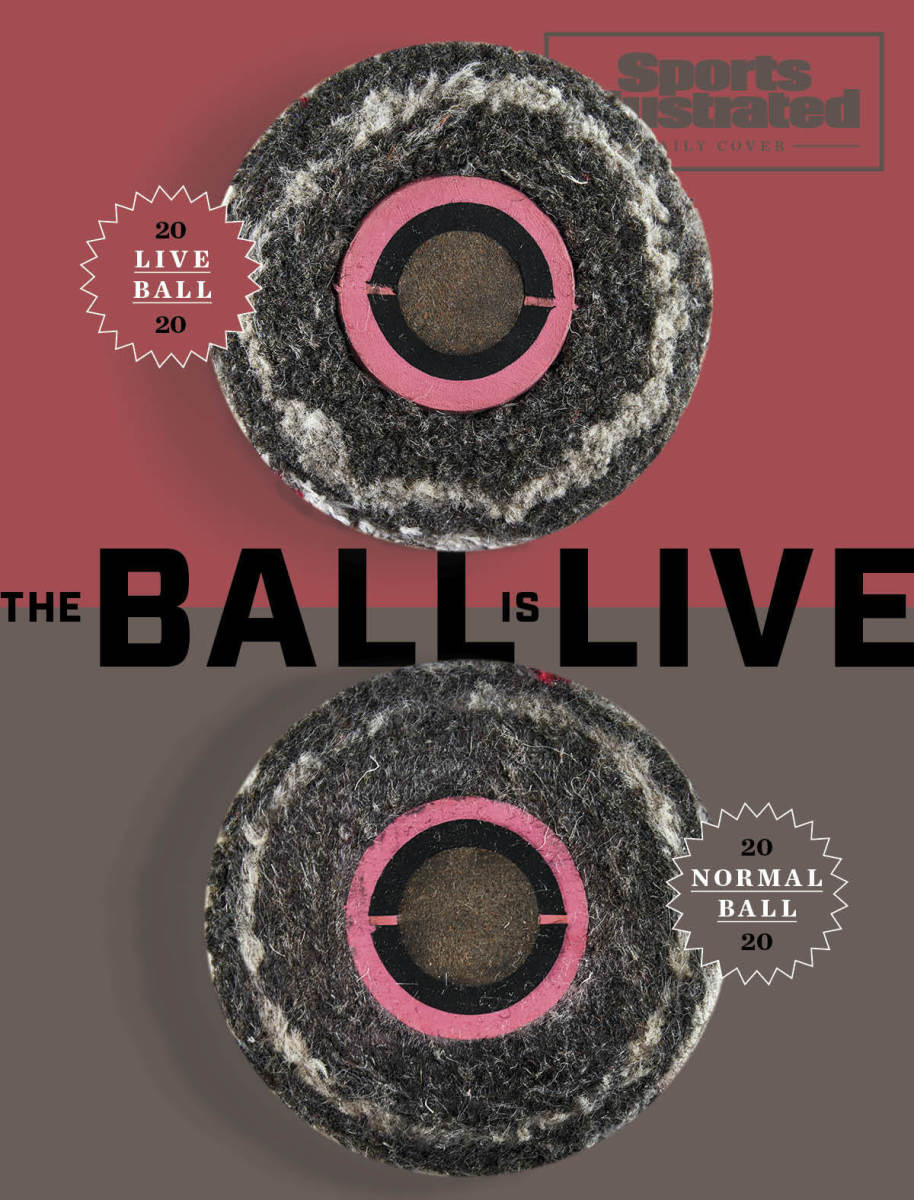
The composition of the ball has been a hot topic since 2015, when players, fans and media first started asking questions as the rate of home runs climbed. Those questions continued through the ’17 season, which saw a record-breaking 6,105 homers, prompting MLB to commission a group of academics and scientists—drawn from the likes of MIT, Stanford and big state schools like Illinois—to investigate as part of its new Committee Studying Home Run Rates. In the report they issued a year later, they determined that the ’17 baseball was more aerodynamic but conceded they could not identify why.
After the ball seemed to even out in 2018, it changed again in ’19, and this time players could tell. Flatter seams caused pitchers to change their grips—and balls to soar. Drives that once would have been long outs left the yard, leading to 6,776 home runs, another record. Outfielders relearned to track deep flies. Then, just as quickly, there was a new ball for the ’19 postseason—one that died on the warning track. MLB’s committee would find that, though the ball was indeed different, there was no evidence “that changes in baseball performance [during the ’19 regular and postseasons] were due to anything intentional.”
Over this same period Dr. Meredith Wills, a 46-year-old astrophysics Ph.D. known for her independent examination of baseballs, conducted five of her own studies and came to similar conclusions: The ball had, in fact, changed multiple times, though only in ways where improved carry appeared to be an unforeseen side effect.
But the balls used in games during MLB’s 2020 season—when dingers flew out at a rate second to only that of 2019—tell a different story, according to Wills, whom SI contracted for the rights to publish her research. After deconstructing and measuring their components, she found that a significant percentage of the 2020 balls were constructed in a way that would likely make them fly farther—and that the changes could have only been deliberate.
MLB and its ball-maker, Rawlings, dispute these findings. The league acknowledges that Rawlings, which it partially owns, did implement experimental changes for a portion of 2020 production, but says that those test balls were within specifications, the changes were actually intended to reduce spring and, besides, the balls were not used in games.
SI first asked MLB last week about its manipulation of baseballs. After the league admitted to SI that it had made adjustments, but insisted that they were minimal, it sent a memo to general managers, assistant general managers and equipment managers informing them of the changes.
This is the first time MLB has publicly acknowledged experimenting with the ball, indicative of its typically close-to-the-vest approach.
After all, to reach her conclusions, Wills had to circumvent MLB’s gatekeepers; devise a way to shield her ball suppliers, like Kyle; and eventually crack a code.
“They’re very shady about things,” Kyle says of MLB. “Everything’s gotta be a secret. It’s not the CIA here, right? This is baseball.”
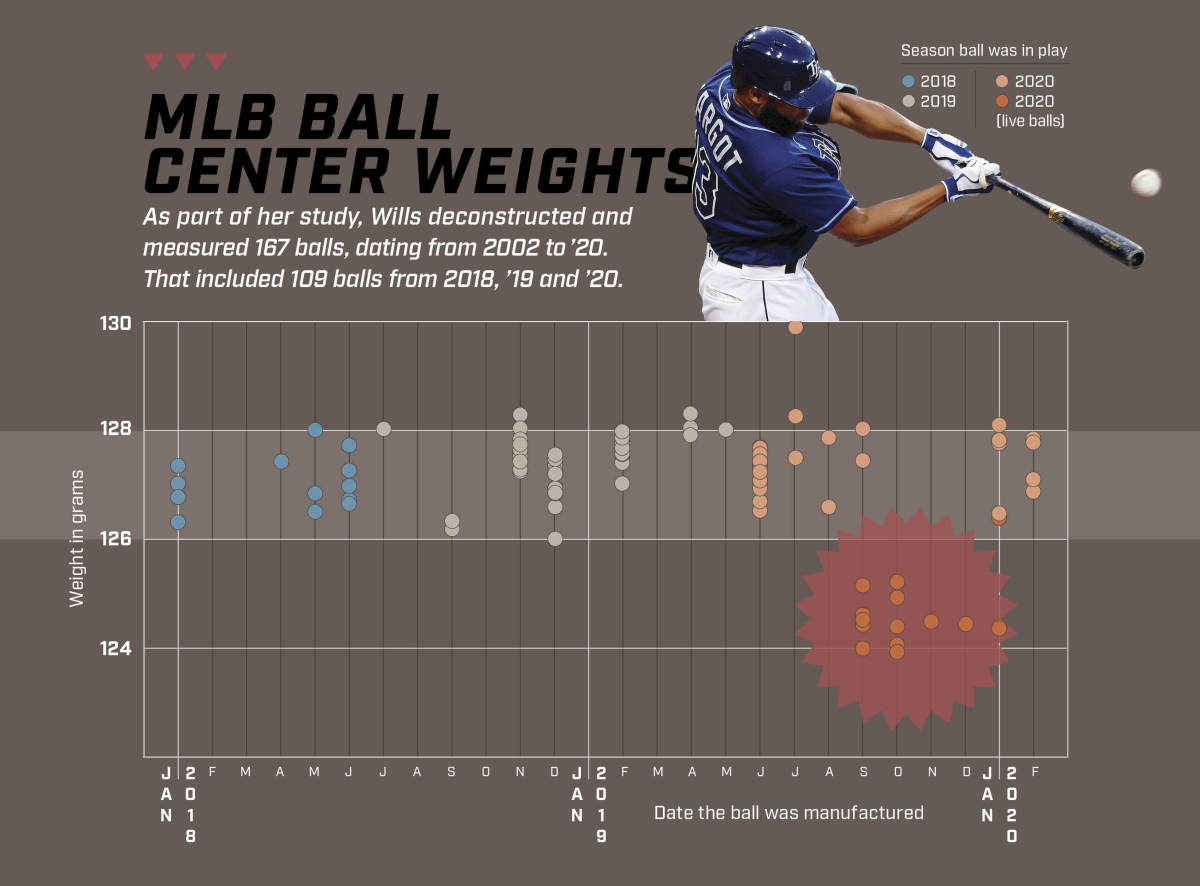
Wills’s journey began in 2018 at her kitchen table in Oshkosh, Wis., surrounded by 26 baseballs and an idiosyncratic set of tools and measuring devices: a box cutter, a T-pin, a tape measure, a kitchen scale, a set of calipers and a single chopstick.
The construction of a baseball begins with a cork-and-rubber core, called the pill, and ends with a stitched leather cover. In between are four wound layers: an inner one of thick gray yarn, surrounded by one of white yarn, then one of thin gray yarn and finally one of white cotton thread. When Wills first took apart a baseball, in 2014, she was interested not in the data but in the fibers: She is an astrophysicist with a long track record working at the intersection of sports and science, but she is also a knitter. She approached the Hall of Fame with a fundraising idea: She would create one-of-a-kind pieces out of the balls’ yarn, which could then be auctioned off to benefit the museum.
Then, during the 2017 home run surge, Alan Nathan, a physicist at the University of Illinois, gave a talk at a baseball analytics seminar suggesting that the ball itself might be responsible for the increase in home runs. Wills was in the audience; suddenly, for her, the ball became science.
She tracked down balls from 2014, ’16 and ’17. She was already in the habit of preserving each ball’s components—a future Hall of Fame design might call for red laces or leather covers—but her, ahem, disem-ball-ments became more systematic. She weighed. She measured. And in May ’18, by using that chopstick to compare how many times the laces could be tightly wound around it, she found a single difference: The home run surge laces required fewer wraps to cover the same portion. The laces on the ’16 and ’17 balls were 9.0% thicker.
Next she connected lace thickness to aerodynamics. She knew that, during production, the flat leather of a baseball must be dampened to stretch over its center; at least until 2018, baseballs were air-dried, which permanently stretched the cotton laces. This caused the balls to deform along the seams. Since thinner laces—like those in the ’14 ball—are weaker, they stretched more. The thicker laces of the ’16 and ’17 balls kept them rounder, leading to more carry.
When home run figures skyrocketed again in 2019, Wills found that the balls’ seams were half the height of previous years. The most likely explanation for the change would be if Rawlings switched from air-drying to heat-drying, a process that prevents the laces from stretching. As a result, the ball would remain round, and tighter laces would effectively “hold down” the seams. Such a ball would have even lower drag and fly out of the park more readily. (Rawlings has in the past denied such a change.)
Then the postseason began. The ball suddenly died and the drag became wildly inconsistent. Wills did two more studies and found that the 2019 postseason used a mix of balls—some from the ’19 regular season and some from another season entirely. A random mix would account both for the sudden lack of carry and the drag variations.
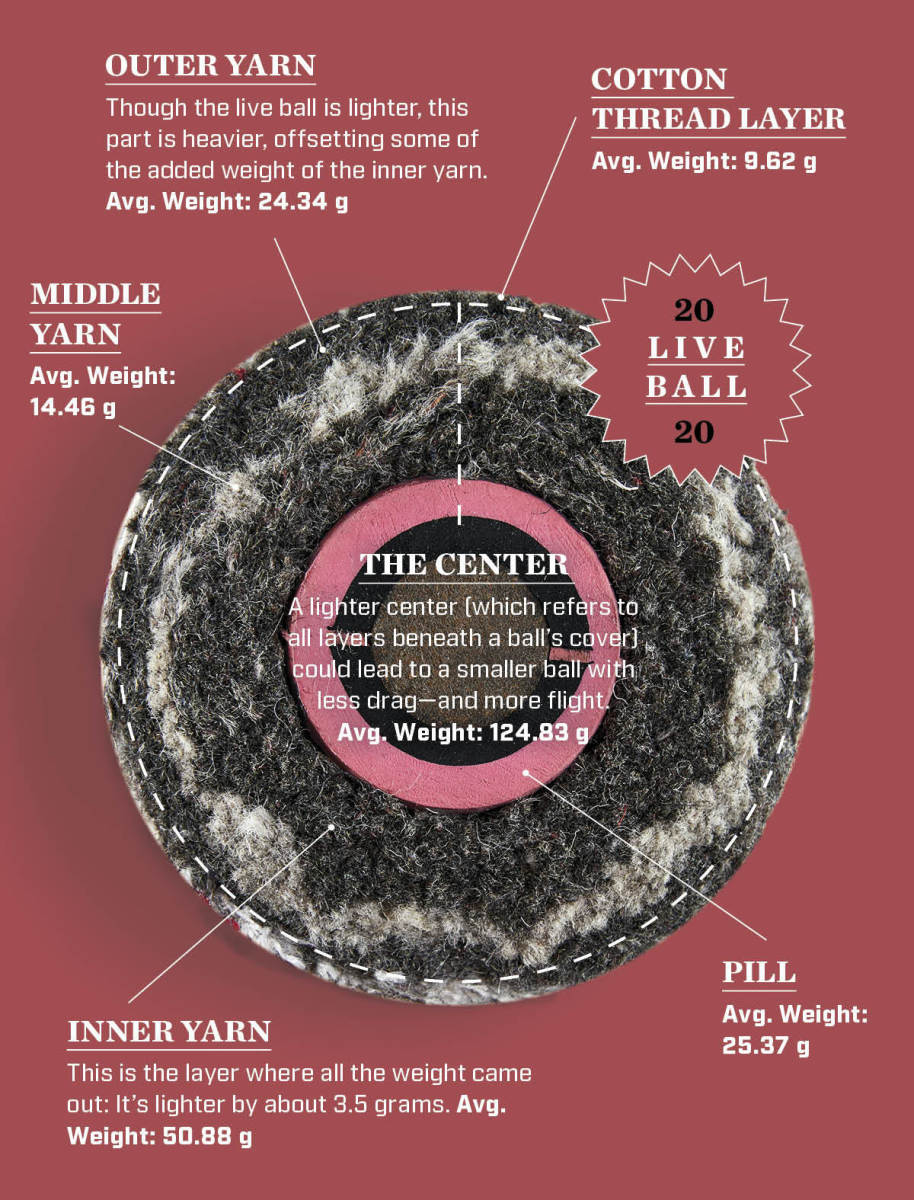
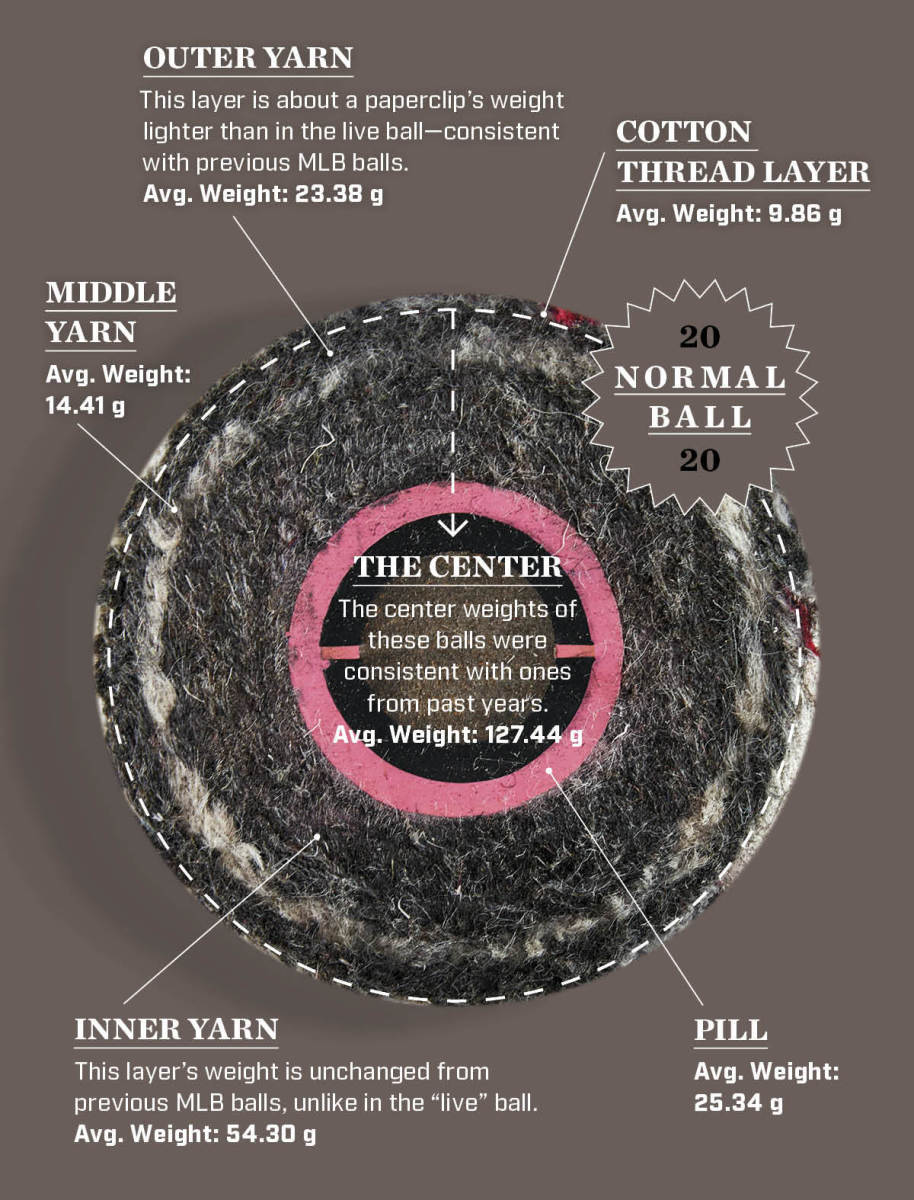
Wills has spoken and published widely on the effects of physical changes to the ball and been nominated for awards from the Society for American Baseball Research (SABR), ultimately winning its 2020 Analytics Conference Research Award for Contemporary Baseball Analysis. As fans and industry professionals took notice of her work, they pressed her to identify some nefarious intent by MLB. Many people around the game suspected that commissioner Rob Manfred had juiced the balls in an attempt to juice declining TV ratings. The league had bought a significant stake in Rawlings, the manufacturer, in 2018. It seemed a straight line from there.
“It’s a f------ joke,” eight-time All-Star righthander Justin Verlander told ESPN in 2019. “Major League Baseball is turning this game into a joke. They own Rawlings, and you’ve got Manfred up here saying it might be the way they center the pill. They own the f------ company. If any other $40 billion company bought out a $400 million company and the product changed dramatically, it’s not a guess as to what happened. We all know what happened. Manfred, the first time he came in, what’d he say? He said we want more offense. All of a sudden he comes in, the balls are juiced? It’s not coincidence. We’re not idiots.”
No one seemed quite sure how Manfred would do such a thing, and there was no concrete evidence that he had. But Verlander was not alone in suspecting a conspiracy.
“There’s not a whole lot of trust,” says Cardinals reliever Andrew Miller.
Indeed, Wills’s baseball-gathering operation at times feels out of a John le Carré novel. To obtain game balls from the 2019 postseason, she devised a completely anonymous system to protect the senders, enlisting a third party as a go-between. She gave that person instructions only over the phone. The person verified the sources’ identities but did not pass them along. In one case, she got a UPS package with the return address ripped off—she still has no idea how somebody managed that.
One person who had intended to send Wills balls later backed out. He explained that MLB could track the team to which they’d been sent and he might be suspected, threatening his job. A league spokesman said he was unaware of any directive against sending balls to Wills. But a clear understanding among her sources seems to exist.
And so every time Wills does an interview, she adds an appeal for game balls. She buys them on eBay. And as she has cultivated sources, they put her in touch with others who might help. Many of them draw paychecks from MLB, but they trust her research more than their employer’s.
She is eager for her studies to be reproduced—as is common for scientists—but she is unaware of any public attempts. Manfred mostly seems aggrieved when asked to address the issue. “If we make a decision to change the baseball, you’re going to hear about it,” he said in July 2019. “We’ve gone back to the scientists and said, ‘We need to figure out why [this is happening].’ ”
Despite public expectations, Wills’s studies had never uncovered anything untoward. All the adjustments to the baseball had innocent explanations. The 2017 change in lace thickness came after Rawlings changed distributors, and a fraction of a millimeter’s difference would not have seemed problematic. In ’19, the league began using the MLB ball at the Triple A level, which required Rawlings to make some 300,000 extra balls; speeding up the drying process would make sense. And as for the postseason, those extra minor league baseballs plus an emphasis on selling more game-used balls to fans suggests that MLB simply ran out and had to dip into supplies from another season. Not only were these changes reasonable, but they were also all legal. The official rules only mention the most basic physical characteristics, making even the ’19 postseason’s use of two different balls completely valid.
When Wills began unlacing the 2020 balls, she expected more of the same: small changes with logical reasons to explain them. She found something else entirely.
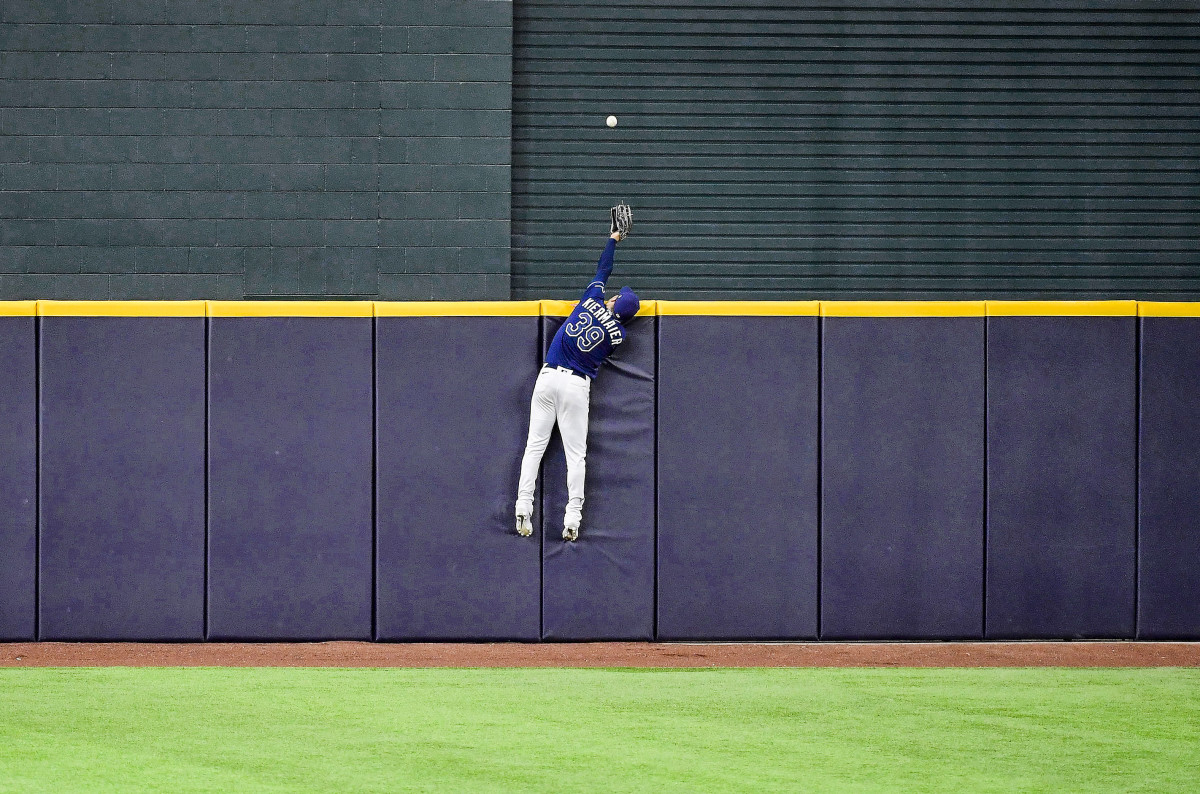
The study began like any of her others, comparing the physical characteristics of different baseballs. Her sample consisted of 18 balls spanning the 2002 and ’13 seasons; 14 from 2014; 13 from 2015; six from 2016; seven from 2017; 22 from 2018; 44 from 2019; and 43 from the 2020 regular season (35 from games; eight stamped "PRACTICE").
The older balls she had already largely deconstructed; most of her new data came from the 2020 sample. External measurements included size (circumference), weight and spherical symmetry. She then unlaced and removed the covers, measuring lace thickness and seam height. This left her with the interior, called the center. After weighing the center itself, she unwound and weighed each of its layers.
From the outside, the 2020 ball seemed normal. The size and weight had a slightly larger spread than previous seasons, but on the whole, the balls conformed to Official Rule 3.01: “The ball . . . shall weigh not less than five nor more than 5 ¼ ounces [142–149 grams] and measure not less than nine nor more than 9 ¼ inches in circumference.” The seams had also returned to pre-2019 height. It appeared as if MLB had rectified the extremes of ’19 and gone back to a consistent baseball that players would recognize.
Then she looked at the centers, and everything changed. Over the past 20 years they have remained remarkably consistent, weighing 126.0 to 127.9 grams. The 2020 ball, on the other hand, split into two distinct groups. Twenty-eight balls (call them 2020N, for normal) had centers similar to those of previous years, weighing 126.8 to 128.1 grams. The other 15 balls (call them 2020L, for live) had centers of 124.2 to 125.4 grams—lighter by around 2.5 grams. That’s about the weight of a penny, and with weights that can be so precisely calibrated, it’s a massive change.
Curiously, while the innermost thick gray yarn was roughly 3.5 grams lighter, decreasing that layer by more than 6%, the outer, thinner yarn layer was actually heavier by a gram, offsetting part of the change.
Wills had never seen anything like this. Within their groups, the overall weights of 2020L and 2020N centers were consistent, each varying less than half a percent. Other studies had demonstrated that a dozen baseballs were enough to draw conclusions, so she knew she had enough to show that the 2% difference between the two groups was too large and too consistent to be an accident. A miscalibration didn’t fit, either. These appeared to be two entirely separate sets of manufacturing parameters.
Such marked changes would be expected to affect the 2020L’s performance. But how? Fortunately, there was good recent evidence. In November 2018, the Korea Baseball Organization announced it would deaden its ball to decrease home runs. Accordingly, its manufacturer, Skyline, made the ball one gram heavier, increased the circumference by one millimeter and decreased the coefficient of restitution (COR), which basically measures the bounciness of a ball. (Think of dribbling a soft, uninflated basketball versus a hard, inflated one.) The result was a ball that traveled, on average, 13 to 16 feet less, leading to a 40.7% home run drop.

The 2020L balls appeared almost the opposite of the KBO ones. Wills couldn’t test COR, but she theorized that a lighter center would be correspondingly smaller, decreasing the average size of the ball itself. Since a smaller ball has less drag, a 2020L would carry farther than a 2020N.
Wills took a step back. She knew from her sources that both 2020L and 2020N balls were from MLB games. Their materials were the same and, moreover, each ball had what is called a batch code stamped on the inside of its cover.
Every baseball manufactured at Rawlings’s Costa Rica factory has a six- or seven-letter inventory designation, corresponding to its production week. To make sense of the 2020L balls, Wills needed concrete production information. Had they been manufactured for a previous season? Were they made alongside the 2020Ns? To find out when they were made, she needed to crack the batch codes.
Fortunately, she had hundreds of samples. After far too much staring, she realized that the codes used only 10 letters. Moreover, those letters could be combined to form a word: blackhorse. For years Rawlings has used a simple cipher using that same word to mark production information on its baseball gloves: B=1, L=2, and so on. When she applied the same code to the balls, there it was. Every string of characters translated into month-month-year-year (or month-month-year) plus a three-digit code corresponding to the week of production. She now had manufacturing dates for every ball in her sample.
To Wills’s surprise, both sets of balls were made during the 2020 production cycle. But the timeline was most unusual. 2020N production began in June ’19 and continued through August. Manufacturing then switched over to 2020L, whose production extended from September ’19 into January ’20. At that point, Rawlings reverted, manufacturing 2020N baseballs from January ’20 through at least February, the final dates in her sample. Since production occurs year-round, it tracks that at least a third of 2020 baseballs would have been 2020L, resulting in a season in which one in three balls might be expected to fly farther.
Naturally, a farther-flying ball would lead to longer home runs. To determine whether the 2020Ls truly were live, Wills used MLB Statcast data to see if 2020 featured a higher percentage of tape-measure shots. She found that the changes varied from park to park—which made sense, since she could determine no pattern for where the 2020Ls were distributed—but that as many as 16 venues saw more long home runs than normal. For instance, during the 2015 to ’19 regular seasons, 55% of Atlanta’s home runs traveled at least 400 feet; in ’20, that percentage jumped to 75%. (The Braves moved ballparks in ’17, but that had little effect on their home run distances.)
Perplexed players spent 2020 debating ball composition. “There would be times when someone would hit a ball and you’d be like, ‘Man, you got all of that,’ and it would go the warning track,” says Blue Jays righty Ross Stripling. “And then there’d be times you’re like, ‘Dude, you got jammed,’ and it would go opposite field homer. Some seemed to be juiced and some did not. I remember even having conversations and people being like, ‘Dude, you think the balls are juiced?’ You’re like, ‘Well, I don’t know—you remember so-and-so’s hit the other day?’ ‘Yeah, true.’ ”
It is no surprise players were confused. The 2020L and 2020N balls feel the same and look identical to the naked eye, and the weight of their leather covers varies enough to camouflage the changes to the center. As long as the covers are on, it’s not possible to detect a difference, even with a sensitive scale. Wills saw it as the baseball version of Schrödinger’s cat: Only when the ball was put in play did you know whether it was dead or alive.
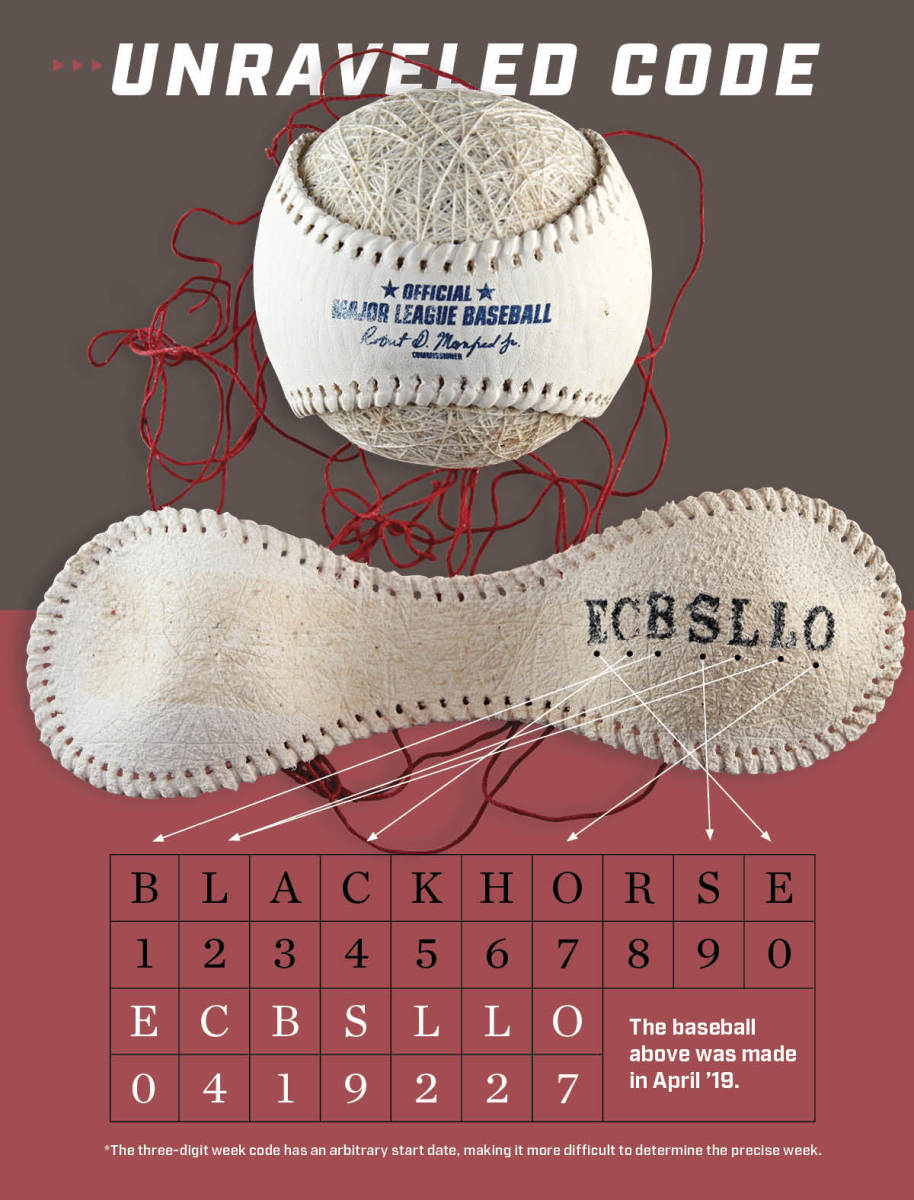
Here is where the situation gets muddy. An MLB spokesman confirmed that Rawlings manufactured test balls in late 2019, implementing changes, as the home run committee recommended, to tighten specifications. He outlined the same information that the league would soon relay to teams in a memo, describing a production change that “adjusted the tension in the first winding” and resulted in a “de minimis”—so trivial as to be meaningless—weight reduction of “less than 1/10 of one ounce,” or about 2.8 grams. (He noted that all the balls in Wills’s study fell within those specifications.) But in the KBO, changes of just one gram to the ball contributed to affecting its flight.
The spokesman also said that the test balls were authorized for use only in spring training and practice. But two-thirds of Wills’s 2020L balls were from regular-season games.
He added, “The manufacturing change was successful in returning the ball to the center of the specification range as recommended by the independent panel of experts, and our plan is to use these balls in 2021 regular-season play.” But the 2020L weights were systematically low.
Nathan, who leads MLB’s home run committee, said in an email, “The goal of the process change was to reduce the ‘spring’ or ‘bounciness’ (technically, the COR) of the baseball to bring it closer to the mid-range of the MLB specification. Measurements from both Rawlings and the UMass Lowell test laboratory show that the desired effect was achieved, resulting in a small reduction in the distance of a typical fly ball.”
It is almost as if the Wills-SI findings exist in a reality separate from MLB’s: Wills found live balls, and Nathan is talking about dead ones. So what gives? It is indeed possible that the league tried to deaden the ball and ended up juicing it. It is possible that balls intended for practice were used in games. It is even possible that everybody is mistakenly talking about different sets of balls. But the opacity with which MLB handles all this breeds confusion and distrust.
“None of it really adds up,” says a longtime baseball factory inspector. He does not work at Rawlings, but requested anonymity for fear of retribution from MLB. If he saw a 0.1 oz change—MLB’s de minimis—he says he would flag it immediately. “That’s a big percentage,” he says. “That would raise eyebrows.” He says the changes Wills found could have been only deliberate, but they don’t seem to match up with the experimentation the league described.
All of this raises important questions for MLB, including how it decides which balls get shipped to which teams. And most importantly, should these changes be made in secret?
Until MLB provides answers, balls will continue to leave the park—whether off bats or in the pockets of people like Kyle, who want to know the truth.
Additional research contributed by Joseph McMahan, Laura Peebles, Christopher Sorley, and Shawn and Susan Bosman
